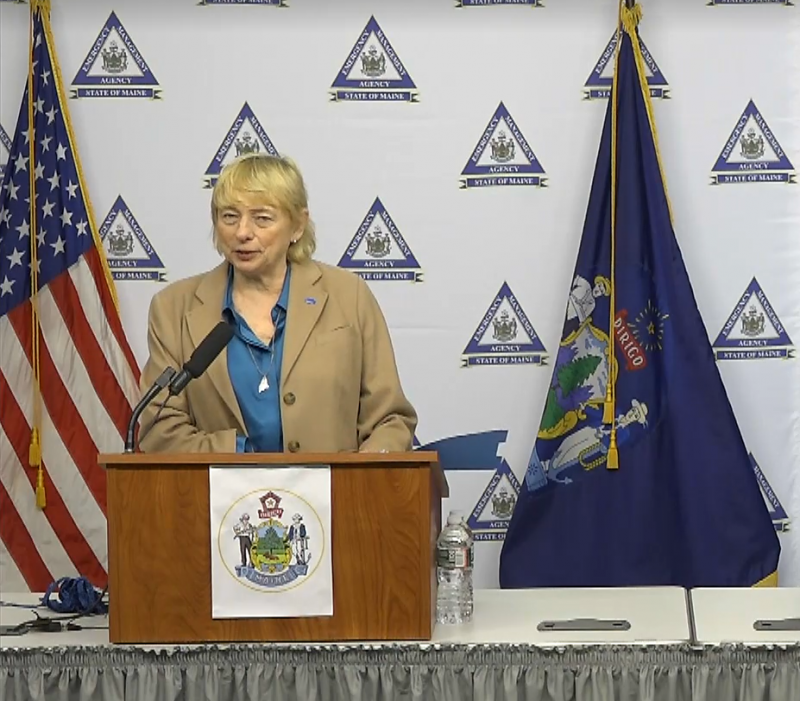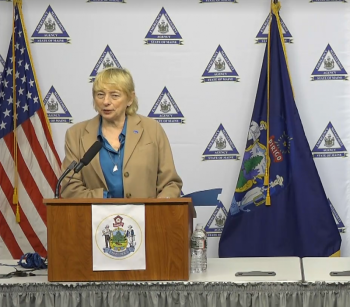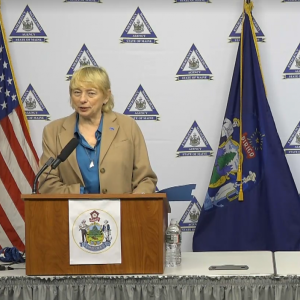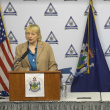Governor Mills announces actions to advance floating offshore wind research array in Gulf of Maine
Governor Janet Mills today proposed a series of actions to advance the nation’s first floating offshore wind research array in federal waters and to protect Maine’s more heavily fished state waters.
In a letter to Maine’s licensed commercial fishermen (PDF), Governor Mills announced that she will propose for the Legislature’s approval a 10-year moratorium on new offshore wind projects in waters managed by the state and that she has directed the Governor’s Energy Office to review offshore wind regulations and again opened channels and opportunities for meaningful input from fishermen and marine industries siting the proposed research array.
These actions seek to protect fishing and recreational opportunities within the three miles of coastal waters managed by the state, which are more heavily fished than federal waters. The actions also allow for additional substantive input from the fishing industry as the Maine continues to pursue the nation’s first floating offshore wind research array in the Gulf of Maine and its associated economic and energy benefits.
“Offshore wind is a significant clean energy and economic opportunity for Maine, which we will pursue responsibly, transparently and in consultation with our fishing and maritime industries,” said Governor Mills. “By focusing on floating offshore technology deep in the Gulf of Maine where the wind is strongest, we will protect Maine’s maritime heritage and coastal economy while being out front in this new competitive industry.”
“This moratorium is an important step that will allow us to continue to alleviate concerns expressed by fishermen and will give us an opportunity to have a more focused conversation around the proposed research array,” said Maine Department of Marine Resources Commissioner Patrick Keliher. “We will continue to work to see that all stakeholders are afforded the opportunity to have a voice in the decision-making process. Maine fishermen are vital to our state’s economy and heritage and I applaud Governor Mills’ decision to support their opportunity for input into the shared use of our state’s valuable marine resources.”
“With some of the most ambitious renewable energy goals in the country and over a decade of experience in offshore wind, Maine can embrace the potential of offshore wind to provide clean energy for our state,” said Dan Burgess, Director of the Governor’s Energy Office. “The research array puts Maine in the driver’s seat to ensure offshore wind benefits the state and minimizes harm, which is why focusing on research is best for the state to both address the growing threat of climate change and to maximize its economic benefits.”
Since taking office, Governor Mills has made the development of renewable energy a top priority for fighting climate change and growing Maine’s economy. In June 2019, she announced the Maine Offshore Wind Initiative to guide the responsible development of an offshore wind industry in Maine.
As part of the initiative, Governor Mills in November announced the state’s intention to create the nation’s first floating offshore wind research array, which garnered broad support from leading economic, labor and environmental organizations in Maine, as well as bipartisan support from Maine’s congressional delegation.
The research array is proposed for an area 20-40 miles in the Gulf of Maine in a proximate location that would allow the array to connect to the energy grid in southern Maine. The most likely locations for that connection have been determined to be either Wyman Station in Yarmouth or Maine Yankee in Wiscasset.
Starting in late December, the Governor’s Energy Office and Department of Marine Resources initiated discussions with Maine’s fishing industry and other stakeholders to determine a site for the research array in the broad area of the Gulf of Maine that meets basic siting criteria. In addition to the mainland grid connection, the site for the array would also require suitable water depths and bottom topography to support the experimental floating offshore wind turbines.
No decision has yet been made on a site, which as a research array, is only expected to cover some 16 square miles of ocean or fewer and contain no more than a dozen turbines. This limited scope is approximately one-tenth the size of comparable commercial-scale offshore wind farms elsewhere in New England and was purposefully done by Governor Mills as a reasonable and measured step forward to pursuing this new technology.
As the first floating offshore wind research array in the U.S., the array would study how the new technology interacts with the marine environment, the fishing industry, and performs both generating energy and sending it to the mainland grid. Permitting and construction of the floating array is expected to take up to five years, in advance of a research period of roughly 20 years. After this period, the array would be decommissioned.
As envisioned, the research array would use floating offshore wind technology pioneered over the past decade by the University of Maine’s Advanced Structures and Composites Center. Last summer, the University announced a new $100 million partnership with two global leaders in offshore wind energy, Diamond and RWE Renewables, to develop its emerging technology through a new company called New England Aqua Ventus.
Separately from the research array, New England Aqua Ventus is permitted to establish a single-turbine demonstration site for its technology in state-managed waters near Monhegan. As a permitted project, this site would not be subject to the proposed 10-year moratorium. There are no current applications for offshore wind projects in state-managed waters, where a majority of Maine’s commercial fishing occurs.
Estimated to drive some $70 billion investment over the next decade alone, offshore wind has become a priority by many states on the eastern seaboard to meet growing demands for clean, renewable energy to combat climate change and the severe economic disruption caused by the COVID-19 pandemic. There is more than 25,000 megawatts of offshore wind energy in the development pipeline along the east coast.
With some of the highest sustained offshore wind speeds in the world, the federally managed waters of the Gulf of Maine are a likely destination for commercial-scale wind projects to meet growing energy demands. Proposing a research array is a prudent, proactive step for Maine to ensure Maine’s interests and values remain foremost in any offshore wind development.
In addition to the research array, the state has also received a $2.16 million federal grant to develop a wide-ranging “roadmap” for offshore wind that will analyze all facets of the industry, from required port infrastructure, supply chain considerations, workforce training and development initiatives, and potential impacts on fishing and the marine environment. Work on the roadmap will begin later this year and will build upon the initial discussions around the research array.
Maine also remains a participant in the Gulf of Maine Task Force, a regional planning effort with Massachusetts and New Hampshire through the federal Bureau of Ocean Energy Management, to evaluate commercial-scale offshore wind projects in the Gulf.
A study of port opportunities in Searsport, as a potential central hub for the offshore wind industry, which would include the transportation, assembly and possibly fabrication of floating turbines, is also underway through the Maine Department of Transportation.
In December, the state of Maine also entered into an agreement with the government of the United Kingdom to share information and resources about the development of offshore wind, marking Maine’s rising place as a recognized global leader in the industry.
Event Date
Address
United States





























